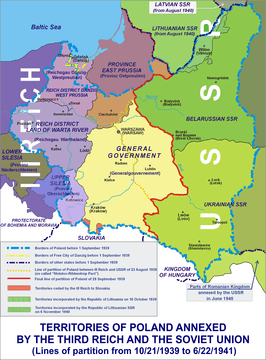Poles in the Wehrmacht
Following the German invasion of Poland in 1939, some Polish citizens of diverse ethnicities served in the Wehrmacht, in particular citizens from parts of Poland annexed to Germany such as Upper Silesia and Pomerania. Service in the German military was universal in nature in these areas, however assessing the number of ethnic Poles involved is difficult due to the fluidity of national identity. At the low end, Polish estimates often place the number of native Poles at 250,000. Ryszard Kaczmarek's conservative estimate, based on documentary evidence, is 295,000; however Kaczmarek considers this very low and is inclined to accept numbers of up to 500,000.[1]

Overall, nearly 90,000 former German personnel served in the Polish forces in the West. By Victory Day in 1945, nearly a third of the Polish servicemembers in the West were formerly in the service of Germany.[2] In the Eastern Front, prisoner-of-war camps for Wehrmacht were a significant recruitment pool for the Polish Armed Forces in the East.[3]
Service in the German military or descent from such individuals ("grandfather in the Wehrmacht") had led in Poland to repression, discrimation and ostriacization. Even in the 21st century, descendants are often excluded from the Polish national collective.[4]
Estimates
Some Polish citizens of diverse ethnicities served in the Wehrmacht and the Waffen-SS, in particular in parts of Poland annexed to Germany such as Upper Silesia and Pomerania. Service in the German military was universal in nature in these areas, however assessing the number of ethnic Poles involved is difficult due to the fluidity of national identity. At the low end, Polish estimates often place the number of native Poles at 250,000. Ryszard Kaczmarek of the University of Silesia in Katowice produced a conservative estimate of at least 295,000 based on documentary evidence, however he consider this very low and is inclined to assume category III Volksliste were mobilized as others, which leads to a maximum estimate of 500,000.[1] Early 1944 estimates by the Polish underground are similar at 400,000-450,000 Poles from Reichsgau Danzig-West Prussia and Silesia.[1]
German authorities assumed those classified as category III Volksliste were in fact mostly ethnically Polish, and marked their military documents with "Pole".[1]
Motivation
Various factors contributed to Polish service in the German military. From the Nazi perspective, racial theory saw Kashubians and Silesians as Volksgemeinschaft. From the Polish perspective, German citizenship was advantegous though it came with obligatory military service. Early German victories in the war, lended glamor to the service. Service was not simple collaboration, but was often a result of adaptation to a complex and fluid situation as well as opportunism.[1] In 1943-1945, German losses at the front led to liberalization of racial rules and mass recruitment of Poles.[1]
In the annexed areas, registration as Volksliste was not only encouraged by the German authorities but also by the Polish Underground State and Catholic Church who wanted to preserve the Polish character of these lands. Thus, in the Katowice district 1.4 million people registered in the Volksliste. The number of residents who refused registration was relatively negligible.[4]
There was also a German storm brigade known as Volksdeutscher Selbstschutz formed by the German minority in Poland. Many of its members were trained in the Third Reich. As soon as the war started, Selbstschutz engaged in widespread massacres of Poles and Jews in West Prussia, Upper Silesia and Reichsgau Wartheland, together with the Einsatzgruppen.[5]
Polish Armed Forces
In the Western Front Polish prisoners were first encountered by the allies in Prisoner-of-war camp for Afrika Korps soldiers. After realizing that a high number of prisoners were Polish, British and Polish Armed Forces in the West created a special section for recruiting POWs for allied service. Recruitment efforts intensified in the summer of 1943.[2]
In January 1944 after Henry Maitland Wilson expressed concern over the lack of Polish replacement troop, General Władysław Anders assured him replacements would be recruited at the front lines. In the II Corps, there were 2,500 ex-POWs by June 1944 which rose to 18,500 by 1945.[2] Anders optimism was founded, and the Polish army in the West ended the war as a larger formation, due to POW recruitment, than its size at the beginning of Italian campaign.[6]
Overall, nearly 90,000 former German personnel served in the Polish forces in the West. By Victory Day in 1945, a third of the Polish servicemembers in the West were formerly in the service of Germany.[2][6]
In the Eastern Front, prisoner-of-war camps for Wehrmacht were a significant recruitment pool for the Polish Armed Forces in the East.[3]
Postwar
Service in the German military or descent from such individuals ("grandfather in the Wehrmacht") has led in Poland to repression, discrimination and ostracization. Even in the 21st century, descendants are often seen as not fully part of the Polish national collective.[4]
During the 2005 Polish presidential election, Donald Tusk was attacked by Law and Justice's Jacek Kurski due to the service of Tusk's grandfather in the Wehrmacht.[4][2]
References
- Kulczycki, John J. (March 7, 2016). Belonging to the Nation. Harvard University Press.
- Kowalska, Magdalena (2015). "A Polish heart in a feldgrau uniform–complicated journeys from the Wehrmacht to the Polish Army in Exile" (PDF). Edukacja Humanistyczna. 2 (33).
- M. Bennett; P. Latawski (November 30, 2004). Exile Armies. p. 36.
- Nijakowski, Lech M. (2009). "Discrimination Against Minorities in Poland on the Basis of History". 39 (3). doi:10.2753/IJS0020-7659390302. Cite journal requires
|journal=(help) - Browning, Christopher R. (1998) [1992]. "Arrival in Poland" (PDF file, direct download 7.91 MB complete). Ordinary Men: Reserve Police Battalion 101 and the Final Solution in Poland. Penguin Books. pp. 51, 98, 109, 124. Retrieved May 1, 2013.
Also: PDF cache archived by WebCite.
- M. Bennett; P. Latawski (November 30, 2004). Exile Armies. p. 35.